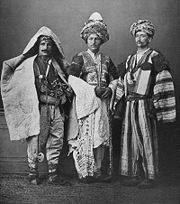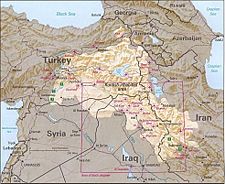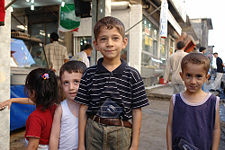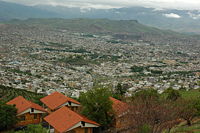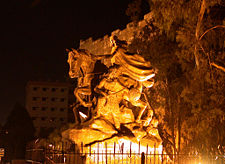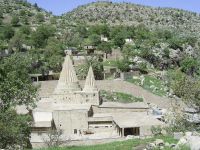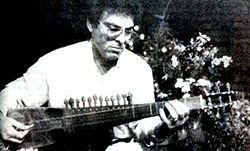Kurdish people
2008/9 Schools Wikipedia Selection. Related subjects: Peoples
| Kurds | ||||||||||||||||||||||||||||||||||||||||||||||||||||||||||||||||||||||||||||||||||||
|---|---|---|---|---|---|---|---|---|---|---|---|---|---|---|---|---|---|---|---|---|---|---|---|---|---|---|---|---|---|---|---|---|---|---|---|---|---|---|---|---|---|---|---|---|---|---|---|---|---|---|---|---|---|---|---|---|---|---|---|---|---|---|---|---|---|---|---|---|---|---|---|---|---|---|---|---|---|---|---|---|---|---|---|---|
| Al-Dinawari • Saladin • Asenath Barzani • Ahmad Xani • Mastoureh Ardalan • Jalal Talabani • Şivan Perwer • Leyla Zana | ||||||||||||||||||||||||||||||||||||||||||||||||||||||||||||||||||||||||||||||||||||
| Total population | ||||||||||||||||||||||||||||||||||||||||||||||||||||||||||||||||||||||||||||||||||||
|
27 to 37.5 million |
||||||||||||||||||||||||||||||||||||||||||||||||||||||||||||||||||||||||||||||||||||
| Regions with significant populations | ||||||||||||||||||||||||||||||||||||||||||||||||||||||||||||||||||||||||||||||||||||
|
||||||||||||||||||||||||||||||||||||||||||||||||||||||||||||||||||||||||||||||||||||
| Languages | ||||||||||||||||||||||||||||||||||||||||||||||||||||||||||||||||||||||||||||||||||||
| Kurdish Persian, Turkish or Arabic spoken widely as second languages Swedish, German, French and English are second languages among expatriates |
||||||||||||||||||||||||||||||||||||||||||||||||||||||||||||||||||||||||||||||||||||
| Religions | ||||||||||||||||||||||||||||||||||||||||||||||||||||||||||||||||||||||||||||||||||||
| Predominantly Sunni Muslim also some Shia, Yazidism, Yarsan, Judaism, Christianity |
||||||||||||||||||||||||||||||||||||||||||||||||||||||||||||||||||||||||||||||||||||
| Related ethnic groups | ||||||||||||||||||||||||||||||||||||||||||||||||||||||||||||||||||||||||||||||||||||
| other Iranian peoples ( Talysh · Baluch · Gilak · Bakhtiari · Persians) |
The Kurds are an Iranian-speaking ethnolinguistic group indigenous to a region often referred to as Kurdistan, an area that includes adjacent parts of Iran, Iraq, Syria, and Turkey. Kurdish communities can also be found in Lebanon, Armenia, Azerbaijan ( Kalbajar and Lachin, to the west of Nagorno Karabakh) and, in recent decades, some European countries and the United States (see Kurdish diaspora). They speak Kurdish, an Indo-European language of the Iranian branch. The origins of the group and relationships with historical entities and names are complex and disputed.
Language
The Kurdish language belongs to the north-western sub-group of the Iranian languages, which in turn belongs to the Indo-Iranian branch of the Indo-European family. The older Hurrian language of the people inhabiting the Kurdish areas was replaced by Indo-European around 850 BCE, with the arrival of the Medes to Western Iran. Nevertheless, Hurrian influence on Kurdish is still evident in its ergative grammatical structure and toponyms.
Most Kurds are bilingual or polylingual, speaking the languages of the surrounding peoples such as Arabic, Turkish and Persian as a second language. Kurdish Jews and some Kurdish Christians (not be confused with ethnic Assyrians of Kurdistan) usually speak Aramaic (for example: Lishana Deni) as their first language. Aramaic is a Semitic language related to Hebrew and Arabic rather than Kurdish.
The Kurdish language is comprised of two major dialects and several sub-dialects:
- The Kurmanji dialect group
- The Sorani dialect group
- The Gorani, Feyli, Kermanshahi and Laki sub-dialects.
Commenting on the differences between the "dialects" of Kurdish, Kreyenbroek clarifies that in some ways, Kurmanji and Sorani are as different from each other as English and German, giving the example that Kurmanji has grammatical gender and case-endings, but Sorani does not, and observing that referring to Sorani and Kurmanji as "dialects" of one language is supported only by "their common origin...and the fact that this usage reflects the sense of ethnic identity and unity of the Kurds."
Population
The exact number of Kurdish people living in the Middle East is unknown, due to both an absence of recent census analysis and the reluctance of the various governments in Kurdish-inhabited regions to give accurate figures.
According to the CIA World Factbook, Kurds comprise 20% of the population in Turkey, 15-20% in Iraq, perhaps 8% in Syria, 7% in Iran and 1.3% in Armenia. In all of these countries except Iran, Kurds form the second largest ethnic group. Roughly 55% of the world's Kurds live in Turkey, about 20% each in Iran and Iraq, and a bit over 5% in Syria.. These estimates place the total number of Kurds at somewhere between 27 and 36 million.
History
Origins
It was formerly considered sufficient to describe the Kurds as the descendants of the Carduchi (Gordyaei), who opposed the retreat of the Ten Thousand through the mountains in the 4th century BC. Kurds now consider themselves to be Indo-European who are descendants of multiple groups (including many non-Indo-European) believed to have settled in what they now refer to as Kurdistan, over a period of thousands of years.
Early cultures included the Halaf and Ubaid. The Hurrian period in the mid third millennium BC is the earliest well-documented period. The 3rd millennium was the time of the Guti (Kurti) and Hattians. The 2nd and 1st millennium BC were the time of the Kassites, Mitanni, Mannai ( Mannaeans), Urartu, and Mushku. All of these peoples shared a common identity and spoke one language or closely related languages or dialects. These groups are thought to have been non-Indo-Europeans, apart from the original Mitanni leadership. The Median Empire was dominant from the 630s BC to 550 BC, and by 400 BC the Carduchi had established a culture independent from the Persian Empire.
Other ancient groups included the Mard, Adiabene, Zila and Khaldi.
Ancient period
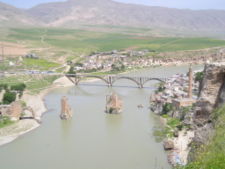
The present-day home of the Kurds, the high mountain region south and south-east of Lake Van between Persia and Mesopotamia, was in the possession of Kurds before the time of the ancient Greek historian Xenophon, and was known as the country of the Carduchi, Cardyene or Cordyene. Xenophon referred to the Kurds in the Anabasis as "Kardukhi...a fierce and protective mountain-dwelling people" who attacked Greek armies in 400 BCE.
The kingdom of Cordyene or Corduene was a high mountain region south and south-east of Lake Van between Persia and Mesopotamia, and it was situated to the east of Tigranocerta (east and south of present-day Diyarbakır). The word Corduene is no doubt the ancient representative of the modern Kurdistan, and means a country in which Kurds dwelt. Kurds seem to have been at one time the chief inhabitants of the Mons Masius, the modern Jebel Kara Dagh and Jebel Tur, which was then called Gordyene, or the Gordisean mountain chain.
Corduene became a province of the Roman Empire in 66 BC and was under Roman control for four centuries until 384 CE. The Roman historian Pliny, considered Cordueni (inhabitants of Corduene) descendants of Carduchis. He stated, Joining on to Adiabene are the people formerly called the Carduchi and now the Cordueni, past whom flows the river Tigris... The people of Corduene were known to have worshipped the Hurrian sky God Teshub.
Medieval period
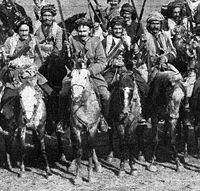
In the seventh century, the Arabs possessed the castles and fortifications of the Kurds. The conquest of the cities of Sharazor and Aradbaz took place in the year 643 CE.
In 846 CE, one of the leaders of the Kurds in Mosul city revolted against the Caliph Al Mo'tasam who sent the famous commander Aitakh to combat against him. In this war, Aitakh proved victorious and killed many of the Kurds. In 903 AC, during the period of Almoqtadar, the Kurds revolted again. Eventually Arabs conquered the Kurdish regions and gradually converted the majority of Kurds to Islam.
In the second half of the tenth century, the Kurdish area was shared amongst four big Kurdish principalities. In the North were the Shaddadid (951–1174) in parts of present-day Armenia and Arran, and the Rawadid (955–1221) in Tabriz and Maragheh. In the East were the Hasanwayhids (959–1015) and the Annazid (990–1117) in Kermanshah, Dinawar and Khanaqin. In the West were the Marwanid (990–1096) of Diyarbakır. After these, the Ayyubid (1171–1250) of Syria and the Ardalan dynasty (14th century to 1867) were established in present-day Khanaqin, Kirkuk and Sinne.
Modern history
In Iraq
Kurds make around 17% of Iraq's population. They are the majority in at least three provinces in Northern Iraq which are known as Iraqi Kurdistan. Kurds also have a presence in Kirkuk, Mosul, Khanaqin, and Baghdad. There are around 300,000 Kurds living in the Iraqi capital Baghdad, 50,000 in the city of Mosul and around 100,000 Kurds living elsewhere in Southern Iraq. Kurds led by Mustafa Barzani were engaged in heavy fighting against successive Iraqi regimes from 1960 to 1975. In March 1970, Iraq announced a peace plan providing for Kurdish autonomy. The plan was to be implemented in four years. However, at the same time, the Iraqi regime started an Arabization program in the oil rich regions of Kirkuk and Khanaqin. The peace agreement did not last long, and in 1974, the Iraqi government began a new offensive against the Kurds. Moreover in March 1975, Iraq and Iran signed the Algiers Accord, according to which Iran cut supplies to Iraqi Kurds. Iraq started another wave of Arabization by moving Arabs to the oil fields in Kurdistan, particularly those around Kirkuk. Between 1975 and 1978, two-hundred thousand Kurds were deported to other parts of Iraq.
During the Iran-Iraq War in the 1980s, the regime implemented anti-Kurdish policies and a de facto civil war broke out. Iraq was widely-condemned by the international community, but was never seriously punished for oppressive measures such as the mass murder of hundreds of thousands of civilians, the wholesale destruction of thousands of villages and the deportation of thousands of Kurds to southern and central Iraq. The campaign of Iraqi government against Kurds in 1988 was called Anfal ("Spoils of War"). The Anfal attacks led to destruction of two thousand villages and death of between fifty and one-hundred thousand Kurds.
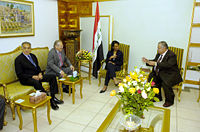
After the Kurdish uprising in 1991 ( Kurdish:Raperîn) led by the PUK and KDP, Iraqi troops recaptured the Kurdish areas and hundreds of thousand of Kurds fled to the borders. To alleviate the situation, a "safe haven" was established by the Security Council. The autonomous Kurdish area was mainly controlled by the rival parties KDP and PUK. The Kurdish population welcomed the American troops in 2003 by holding celebrations and dancing in the streets. The area controlled by peshmerga was expanded, and Kurds now have effective control in Kirkuk and parts of Mosul. By the beginning of 2006, the two Kurdish areas were merged into one unified region. A series of referendums are scheduled to be held in 2007, to determine the final borders of the Kurdish region.
In Turkey
About half of all Kurds live in Turkey. According to the CIA Factbook they account for 20 percent of the 70 million people of Turkey, thus numbering about 15 million people. Other estimates vary between 12 to 15 million. They are predominantly distributed in the southeastern corner of the country.
The best available estimate of the number of persons in Turkey speaking a Kurdish-related language is about five million (1980). There are about one million speakers of Dimli (Southern Zaza), and about 140,000 speakers of Kirmanjki (Northern Zaza), which has about 70 percent lexical similarity with Dimli. These estimates are from 1999 in the case of Dimli and 1972 in the case of Kirmanjki. About 3,950,000 others speak Northern Kurdish ( Kurmanji) (1980). While population increase suggests that the number of speakers has grown, it is also true that use of the language has been discouraged in Turkish cities, and that many fewer ethnic Kurds live in the countryside where the language has traditionally been used. The number of speakers is clearly less than the 15 million or so persons who identify themselves as ethnic Kurds.
From 1915 to 1918, Kurds struggled to end Ottoman rule over their region. They were encouraged by Woodrow Wilson's support for non-Turkish nationalities of the empire and submitted their claim for independence to the Paris Peace Conference in 1919. The Treaty of Sèvres stipulated creation of an autonomous Kurdish state in 1920, but the subsequent Treaty of Lausanne in 1923 failed to mention Kurds. In 1925 and 1930, Kurdish revolts were forcibly suppressed.
Following these events, the existence of distinct ethnic groups like Kurds in Turkey was officially denied and any expression by the Kurds of their ethnic identity was harshly repressed. Until 1991, the use of the Kurdish language – although widespread – was illegal. As a result of reforms inspired by the EU, music, radio and television broadcasts in Kurdish are now allowed albeit with severe time restrictions (for example, radio broadcasts can be no longer than sixty minutes per day nor constitute more than five hours per week while television broadcasts are subject to even greater restrictions). Additionally, education in Kurdish is now permitted though only in private institutions.
As late as 1994, however, Leyla Zana, the first female Kurdish representative in Turkey's Parliament, was charged for making "separatist speeches" and sentenced to 15 years in prison. At her inauguration as an MP, she reportedly identified herself as a Kurd. Amnesty International reported that "[s]he took the oath of loyalty in Turkish, as required by law, then added in Kurdish, 'I shall struggle so that the Kurdish and Turkish peoples may live together in a democratic framework.' Parliament erupted with shouts of 'Separatist!', 'Terrorist!', and 'Arrest her!'"
The Partiya Karkerên Kurdistan ( PKK), also known as KADEK and Kongra-Gel, is considered by the US and EU to be a terrorist organization dedicated to creating an independent Kurdish state in a territory (traditionally referred to as Kurdistan) consisting of parts of southeastern Turkey, northeastern Iraq, northeastern Syria and northwestern Iran. It is an ethnic secessionist organization using force and threat of force against both civilian and military targets for the purpose of achieving its political goal.
Between 1984 and 1999, the PKK and the Turkish military engaged in open war, and much of the countryside in the southeast was depopulated, with Kurdish civilians moving to local defensible centers such as Diyarbakır, Van, and Şırnak, as well as to the cities of western Turkey and even to western Europe. The causes of the depopulation included PKK atrocities against Kurdish clans they could not control, the poverty of the southeast, and the Turkish state's military operations. Human Rights Watch has documented many instances where the Turkish military forcibly evacuated villages, destroying houses and equipment to prevent the return of the inhabitants. An estimated 3,000 Kurdish villages in Turkey were virtually wiped from the map, representing the displacement of more than 378,000 people.
Nelson Mandela refused to accept the Ataturk Peace Award in 1992 because of the oppression of the Kurds. After the rejection, Turkish press called him An Ugly African and Terrorist Mandela.
In Iran
The Kurds constitute approximately 7% of Iran's overall population.The Persians, Kurds, and speakers of other Indo-European languages in Iran are descendants of the Aryan tribes that began migrating from Central Asia into what is now Iran in the 2nd millennium BC. According to some sources, "some Kurds in Iran have resisted the Iranian government's efforts, both before and after the revolution of 1979, to assimilate them into the mainstream of national life and, along with their fellow Kurds in adjacent regions of Iraq and Turkey, has sought either regional autonomy or the outright establishment of an independent Kurdish state". While other sources state that "most of the freedoms Turkish Kurds have been eager to spill blood over have been available in Iran for years; Iran constitutionally recognizes the Kurds' language and minority ethnic status, and there is no taboo against speaking Kurdish in public." .
In the 17th century, a large number of Kurds were deported by Shah Abbas I to Khorasan in Eastern Iran and forcibly resettled in the cities of Quchan and Birjand. The Kurds of Khorasan, numbering around 700,000, still use the Kurmanji Kurdish dialect. During the 19th and 20th centuries, successive Iranian governments crushed Kurdish revolts led by Kurdish notables such as Shaikh Ubaidullah (against Qajars in 1880) and Simko (against Pahlavis in the 1920s).
In January 1946, during the Soviet occupation of north-western Iran, the Soviet-backed Kurdish Republic of Mahabad declared independence in parts of Iranian Kurdistan. Nevertheless, the Soviet forces left Iran in May 1946, and the self-declared republic fell to the Iranian army after only a few months and the president of the republic Qazi Muhammad was hanged publicly in Mahabad. After the 1953 Iranian coup d'état, Mohammad Reza Pahlavi became more autocratic and suppressed most opposition including Kurdish political groups seeking greater rights for Iranian Kurds. He also prohibited any teaching of the Kurdish language.
After the Iranian revolution, intense fighting occurred between militant Kurdish groups and the Islamic Republic between 1979 and 1982. In August 1979, Ruhollah Khomeini declared a " holy war" against the Kurdish rebels seeking autonomy or independence, and ordered the Armed Forces to move to the Kurdish areas of Iran in order to push the Kurdish rebels out and and restore central rule to the country. An image of a firing squad of Revolutionary Guards executing Kurdish prisoners around Sanandaj gained international fame and won the Pulitzer Prize in 1980. The Islamic Revolutionary Guards Corps fought to reestablish government control in the Kurdish regions; as a result, around ten thousand Kurds were killed. Since 1983, the Iranian government has maintained control over the Iranian Kurdistan. Frequent unrest and the occasional military crackdown have occurred since the 1990s.
In Iran, Kurds express their cultural identity freely, but are denied the right of self-government or administration. Similar to other parts of Iran, membership of any non-governmental political party in Kurdistan could be punishable by persecution, imprisonment and even death. Kurdish human rights activists in Iran have been threatened by Iranian authorities in connection with their work. Following the killing of Kurdish opposition activist Shivan Qaderi and two other Kurdish men by Iranian security forces in Mahabad on July 9, 2005, six weeks of riots and protests erupted in Kurdish towns and villages throughout Eastern Kurdistan. Scores were killed and injured, and an untold number arrested without charge. The Iranian authorities have also shut down several major Kurdish newspapers and arrested editors and reporters. Among those was Roya Toloui, a womens' rights activist and head of the Rasan ("Rising") newspaper in Sine, who was tortured for two months for alleged involvement in the organization of peaceful protests throughout Kurdistan province. According to the International Crisis Group, Kurds, who live in the least developed part of Iran, pose the most serious internal problem for Iran to resolve, and their apparent success in self-rule fuels their demands for greater autonomy.
In Syria
Kurds and other Non-Arabs account for 10% of Syria's population, a total of around 1.9 million people. This makes them the largest ethnic minority in the country. They are mostly concentrated in the northeast and the north, but there are also significant Kurdish populations in Aleppo and Damascus. Kurds often speak Kurdish in public, unless all those present do not. Kurdish human rights activists are mistreated and persecuted. No political parties are allowed for any group, Kurdish or otherwise.
Techniques used to suppress the ethnic identity of Kurds in Syria include various bans on the use of the Kurdish language, refusal to register children with Kurdish names, the replacement of Kurdish place names with new names in Arabic, the prohibition of businesses that do not have Arabic names, the prohibition of Kurdish private schools, and the prohibition of books and other materials written in Kurdish. Having been denied the right to Syrian nationality, around three-hundred thousand Kurds have been deprived of any social rights, in violation of international law. As a consequence, these Kurds are in effect trapped within Syria. In February 2006, however, sources reported that Syria was now planning to grant these Kurds citizenship.
On March 12, 2004, beginning at a stadium in Qamishli (a largely Kurdish city in northeastern Syria), clashes between Kurds and Syrians broke out and continued over a number of days. At least thirty people were killed and more than 160 injured. The unrest spread to other Kurdish towns along the northern border with Turkey, and then to Damascus and Aleppo.
In Armenia
Between the 1930s and 1980s, Armenia was a part of the Soviet Union, within which Kurds, like other ethnic groups, had the status of a protected minority. Armenian Kurds were permitted their own state-sponsored newspaper, radio broadcasts and cultural events. During the conflict in Nagorno-Karabakh, many non-Yazidi Kurds were forced to leave their homes. Following the end of the Soviet Union, Kurds in Armenia were stripped of their cultural privileges and most fled to Russia or Western Europe.
In Azerbaijan
In 1920, two Kurdish-inhabited areas of Jewanshir (capital Kalbajar) and eastern Zangazur (capital Lachin) were combined to form the Kurdistan Okrug (or "Red Kurdistan"). The period of existence of the Kurdish administrative unit was brief and did not last beyond 1929. Kurds subsequently faced many repressive measures, including deportations. As a result of the conflict in Nagorno-Karabakh, many Kurdish areas have been destroyed and more than 150,000 Kurds have been deported since 1988.
Diaspora
According to a report by the Council of Europe, approximately 1.3 million Kurds live in Western Europe. The earliest immigrants were Kurds from Turkey, who settled in Germany, Austria, the Benelux countries, Great Britain, Switzerland and France during the 1960s. Successive periods of political and social turmoil in the Middle East during 1980s and 1990s brought new waves of Kurdish refugees, mostly from Iran and Iraq under Saddam Hussein, came to Europe. In recent years, many Kurdish asylum seekers from both Iran and Iraq have settled in the United Kingdom (especially in the town of Dewsbury and in some northern areas of London), which has sometimes caused media controversy over their right to remain. There have been tensions between Kurds and the establish Muslim community in Dewsbury, which is home to very traditional mosques such as the Markazi.
There was substantial immigration of Kurds into North America, who are mainly political refugees and immigrants seeking economic opportunity. An estimated 100,000 Kurds are known to live in the United States, with 50,000 in Canada and less than 15,000 in Australia.
Religion
Yazdanism refers to a group of native monotheistic religions practiced among the Kurds: Alevism, Yarsan and Yazidism. The main element in Yazdani faiths is the belief in seven angelic entities that protect the world, therefore these traditions are named as Cult of Angels. The original religion of the Kurds was Yazidism, a religion greatly influenced by Jewish, Zoroastrian, Christian and Islamic beliefs. However, there are significant differences between Yazdanism and Zoroasterianism, such as the belief in re-incarnation. Most Yazidis live in Iraqi Kurdistan, in the vicinity of Mosul and Sinjar. The Yarsan (or Ahl-e Haqq) religion is practised in western Iran, primarily around Kermanshah. Christianity and Judaism both are still practised in very small numbers. Rabbi Asenath Barzani, who lived in Mosul from 1590 to 1670, was among the very first Jewish women to become a rabbi.The overwhelming majority of the Kurdish Jews had immigrated to the Jewish State, Israel, during the early 1950s. For centuries, the Jews had lived as protected subjects of the tribal chieftains (aghas) and survived in the urban centers and villages in which they lived. In return for the protection granted by their aghas, the Jews would ocassionaly give them gifts, services and commissions of their commercial and agricultural transactions.
Today, the majority of Kurds are officially Muslim, belonging to the Shafi school of Sunni Islam. Mystical practices and participation in Sufi orders are also widespread among Kurds. There is also a minority of Kurds who are Shia Muslims, primarily living in the Ilam and Kermanshah provinces of Iran, Central Iraq ( Fayli Kurds). The Alevis are another religious minority among the Kurds, mainly found in Turkey.
It has been said that Kurds "hold their Islam lightly", meaning that their faith tends not to be as assertive as it can become in other areas. One consequence, for example, has been the greater freedoms enjoyed by Kurdish women; they do not cover their faces, their hijab is less restrictive, and they do not wear full-cover garments such as the Iranian chador or Arabic abaya.
Culture
Kurdish culture is a legacy from the various ancient peoples who shaped modern Kurds and their society, but primarily of three layers of indigenous ( Hurrian), ancient Iranian ( Medes), and Islamic roots.
Kurdish culture is close to that of other Iranian peoples. Kurds, for instance, also celebrate Newroz (March 21) as New Year's Day.
Kurdish films mainly evoke poverty and the lack of rights of Kurdish people in the region. Yılmaz Güney ( Yol ) and Bahman Qubadi ( A Time for Drunken Horses, Turtles Can Fly) are among the better-known Kurdish directors.
Music
Traditionally, there are three types of Kurdish Classical performers: storytellers (çîrokbêj), minstrels (stranbêj), and bards (dengbêj). No specific music was associated with the Kurdish princely courts. Instead, music performed in night gatherings (şevbihêrk) is considered classical. Several musical forms are found in this genre. Many songs are epic in nature, such as the popular Lawiks, heroic ballads recounting the tales of Kurdish heroes such as Saladin. Heyrans are love ballads usually expressing the melancholy of separation and unfulfilled love, while Lawje is a form of religious music and Payizoks are songs performed during the autumn. Love songs, dance music, wedding and other celebratory songs (dîlok/narînk), erotic poetry, and work songs are also popular.




